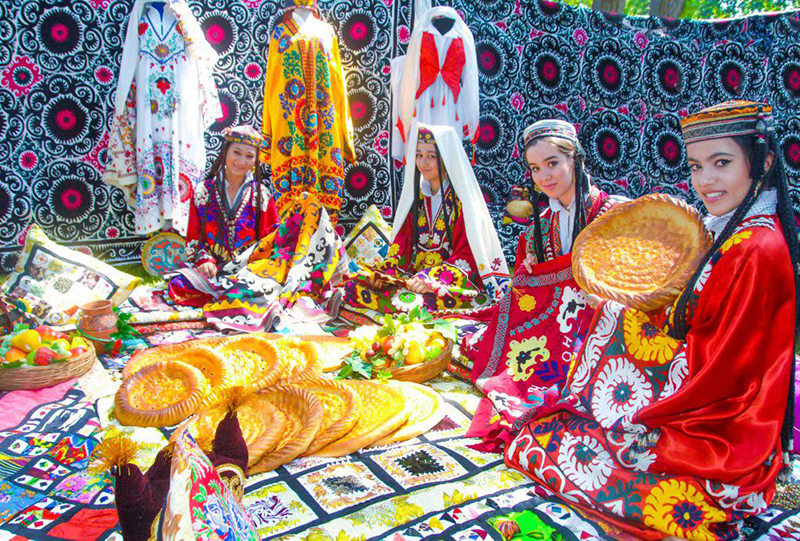Culture of Uzbekistan
The culture of Uzbekistan is vibrant and distinctive, it has been formed over thousands of years and has absorbed the traditions and customs of the peoples who inhabited the territory of modern Uzbekistan at various times.
The ancient Persians, Greeks, nomadic Turkic tribes, Arabs, Chinese, and Russians contributed to it. The traditions of multinational Uzbekistan are reflected in music, dance, painting, applied arts, language, cuisine and clothing. Uzbek culture is the quintessence of the cultures of Central Asia, but at the same time, each region of Uzbekistan has its own unique shades, which is most clearly manifested in national clothes and local dialects.
To get acquainted with this wealth, it is necessary to travel all over the country, however, those wishing to see the entire palette of Uzbek culture in one place should visit the festivals of Uzbekistan, which bring together creative teams from all regions of the republic. It is here that you can see the whole flavor of Uzbek dances, music, applied arts, etc.
Uzbek painting
Painting in Uzbekistan is a reflection of the country's history on the canvases of the masters. One of the oldest paintings is a wall painting from the ancient settlement of Afrosiab. With the advent of Islam, the image of man became forbidden, and abstract painting developed. Later, the art of miniature appeared, which eventually reached perfection, and today is one of the most recognizable trends in the fine arts of Uzbekistan. Kamoliddin Behzod (16th century), Ahmad Donish (19th century), and Abdulkhalik-Makhmum (19th century) are considered to be the best masters of Uzbek miniature painting. In the 20th century, there was a tremendous shift in painting under the influence of Russian ascetic artists, among whom Igor Savitsky is particularly famous for creating a unique museum of painting in Nukus. In the 21st century, Uzbek painting has joined global trends, while maintaining its unique features.
Literature of Uzbekistan
The history of literature in Uzbekistan originates from folklore – legends, epics and fairy tales. The tales of the heroic Alpamysh and the inventive Nasreddin Afandi are an integral part of the culture of Uzbekistan. In the Middle Ages, poets and writers appeared in Uzbekistan, whose names are now known to every inhabitant of the country – Ahmad Yugnaki, Alisher Navoi, Babur, Jami, and others. The literature of Uzbekistan of that era is full of poetry, and the main themes of the works are devoted to love, happiness and wisdom. Serious drama and satire appeared in the works of Uzbek writers in the 19th and 20th centuries. The most famous writers of Uzbekistan of the 20th century are Furkat, Gafur Gulyam, Mukimi, Hamid Alimzhan, Zulfiya, Abdullah Kahhar, and several dozen other writers and poets. Modern literature of Uzbekistan is very diverse, but, unfortunately, it is not as popular as classical literature.
Uzbek Music
The music of Uzbekistan is a unique manifestation of the ancient culture of the Uzbek people. Classical and popular music have similarities with generally accepted concepts of music in the world, but at the same time, due to the special sound of Uzbek musical instruments, they acquire their own unique sound. The most famous musical instruments of Uzbekistan are karnai, surnai, dutar and doira. Musical genres have close ties with folklore and Uzbek poetry. Special and special attention should be paid to shashmak, a special genre of music in Uzbekistan and Tajikistan, which was included by UNESCO in the list of masterpieces of the oral and intangible cultural heritage of mankind. Today, Uzbek folk music can be heard at weddings, celebrations, concerts, as well as at the famous Sharq Taronalari festival, which is held every two years in Samarkand.
Uzbek Dances
Uzbek dances are the epitome of the beauty of the Uzbek people. Uzbek folk dances differ from other oriental dances by a special emphasis on hand movements and facial expressions during performance. At the same time, each region has its own dance schools – some have sharp movements, others have smooth ones, some schools use a short step, while others sometimes switch to a kind of running. Today, there are three main schools of Uzbek dance – Khorezm, Bukhara and Ferghana. It's quite easy to see Uzbek dances, no celebration can do without them, and everyone loves dancing! And also, the flavor of Uzbek dances can be appreciated at the folklore show, which is held daily during the tourist season in Bukhara, in the building of the Nadir Divan Begi madrasah.
Folk crafts of Uzbekistan
Decorative and applied art of Uzbekistan is the most popular part of the culture of the people, which gives tourists a lot of space when choosing souvenirs. Uzbek artisans pass on the secrets of craftsmanship from generation to generation, and their work is distinguished by high quality and special elegance. Blacksmiths, potters, weavers, carvers, and many others create works of art from silk, clay, wood, and metal that are recognizable worldwide for their smooth lines, geometrically perfect patterns, and harmony of form. The most famous craftsmen of Uzbekistan are the ceramicists of Gijduvan and Rishtan, the blacksmiths of Bukhara and Chust, the weavers of Margilan and the winemakers of Samarkand. Often, artisans can arrange workshops in their workshops, and show collections of works in which you can get acquainted with the best creations of their fathers and grandfathers.
